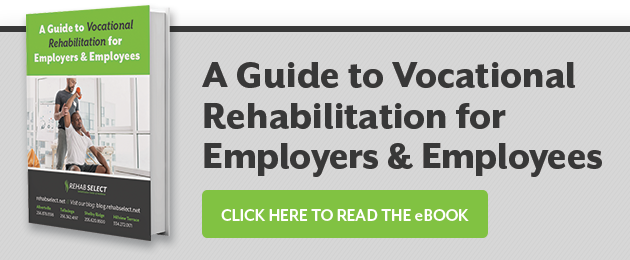 A major injury can cause significant disruptions to your life, including your productivity, income capacity, and employment.
A major injury can cause significant disruptions to your life, including your productivity, income capacity, and employment.
While physical recovery may be your primary focus after a medical incident, your re-entrance into the workforce after an absence may also weigh on your mind, especially as you near the end of your recovery period.
Rehab Select offers a comprehensive inpatient rehabilitation program to help you rebuild your strength, stamina, and function while you recover. Your care doesn’t stop once you leave the inpatient program either.
The providers gear your treatment toward optimal recovery so you can safely and efficiently transition back into work. The tips listed here help ease the process and ensure the best possible outcome among you, your employer, and your healthcare team.
1. Adjust Your Expectations
You might not be able to perform the same on-the-job tasks right away. Have a conversation with your doctor and therapists to hear what their expectations are for your recovery. Don’t be afraid to ask questions like:
- Will I ever be able to perform my duties again?
- How long do you expect full recovery to take?
- What can I do to speed my recovery?
- What modifications do you recommend?
You may have to maintain part-time hours for a period of time or hand some of your duties off to a colleague. You may also get tired more easily. It’s helpful to get an idea of what to expect to avoid discouragement.
2. Make Necessary Adjustments
Your doctor and physical therapist may make modification recommendations in your Return to Work forms. You can work with your employer and healthcare providers to make reasonable adjustments so you can perform your job.
Your providers may give you assistive devices or recommend workspace adjustments to ensure your health and safety. For example, you may need assistance or a wheeled cart to move heavy loads if you’re under weight restrictions.
Your healthcare team and employer have many options to meet you where you are in your recovery and allow you to perform at the best of your ability.
3. Pace Yourself
You may be tempted to try and do more than your healthcare providers recommend, such as lift heavy objects or work longer hours. On the other hand, you may think you need more rest than you’ve been given after your medical event.
Getting back into your normal routine is often beneficial for your recovery. The physical activity builds momentum behind your recovery and the social aspect restores your interpersonal relationships and sense of self-efficacy.
However, you don’t want to jump into work faster than recommended, even if you feel ready. You may end up re-injuring yourself or causing new problems, which could put you at even more of a disadvantage. Trust your doctor’s guidance and the rate at which they recommend you transition.
4. Take a Cooperative Approach
Your return to work shouldn’t be a battle between you and your employer or set your healthcare team against your workplace. Your return to work benefits everyone, and your employers are often happy to work as a team with you and your medical providers to ensure your safe, skillful return to work.
In fact, in most worker’s compensation and FMLA cases, your employers are legally obligated to restore you to the same or an equivalent position when you return. The laws and responsibilities of both parties are meant to be mutually beneficial.
Your Return to Work plan from your doctor should lay out the exact path you’ll use to reenter the workforce so there are no questions about how or what the transition entails. As long as everyone takes a cooperative approach toward a common goal, everyone involved can reap the most productive outcome.
5. Use Preventive Measures
One of the best ways to protect your health going forward is to take preventive measures against future injury. Prevention helps you avoid ending up in the same situation again or creating a whole new set of problems.
For example, if you had shoulder surgery, you may need to perform daily exercises, wear a sling, and use ergonomic desk equipment to help prevent shoulder problems from recurring. Your doctor and therapists can point out vulnerabilities and teach you how to avoid irritating or further injuring the area.
Your doctor can also help you establish lifestyle habits to promote your overall health and well-being. Rehab Select offers vocational rehabilitation, nutritional services, and physical therapy to establish long-term protective benefits as part of the inpatient rehab program.
Whether your medical event involves a worker’s compensation case or long-term disability, the providers at Rehab Select promote your quick, safe return to work. By using the guidelines outlined above and following an inpatient rehab program, you will enjoy a smoother transition returning to work.





